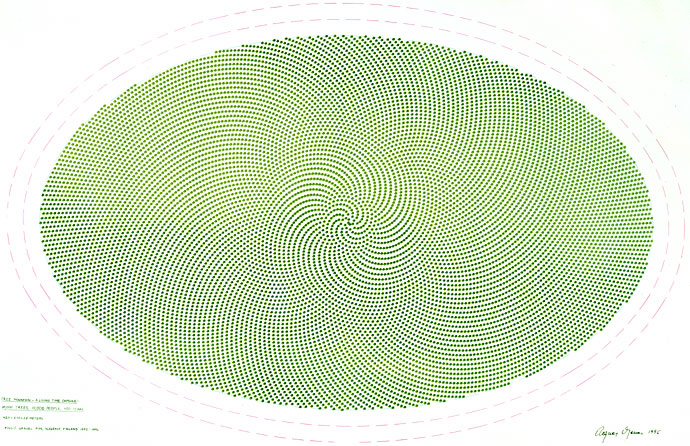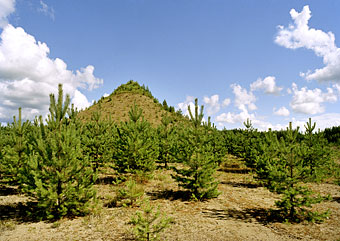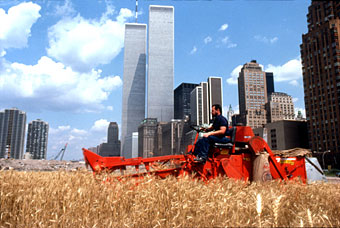
Some of my work deals with inner space, visualizing invisible processes such as time, mathematics, logic, thinking processes, evolution. Other works are dealing with very large spaces, large by necessity in order to rebuild our environment and make a difference. As difficult as it is to realize these works, it is absolutely necessary to make them happen all over the world as examples of what needs to be done to restore landfills, or destroyed barren land where resource extraction has taken its toll, and on deforested soil to stop erosion, purify the air, protect fresh groundwater and provide home for wildlife. And it is important to do them in the nervous tension of cities to afford people a chance to stay in touch with nature. And on the journey inward, it is equally important to give analytical propositions shape and form for better understanding.
(The above are excerpts from Notes on Eco-Logic, Visual Philosophy, Global Perspective and Environmental Art, 1968-1993, by Agnes Denes, in Leonardo, Vol. 26, No. 5, 387-395, 1993.)
I believe that artistic vision, image and metaphor are powerful tools of communication that can become expressions of human values with profound impact on our consciousness and collective destiny.
My work is a composition, a process, a place, a field of grain, a mathematical forest, benign problem solving, nature articulated through human intelligence, philosophy in the land.
I plant forests on abused land to be kept alive for centuries and fields of grain in the heart of megacities. This work goes beyond just planting a field or a forest, or creating masterplans for large spaces. It is benign problem solving and shaping, structuring the future: an egoless art form that calls attention to social concerns and involves people from all walks of life. It builds pride and self esteem in people and benefits future generations with a meaningful legacy.
Rice/Tree/Burial was my first ecological site work in l968 that announced my commitment to environmental concerns, and the creation of a new aesthetic.
Wheatfield—A confrontation: After months of preparations, in May l982, a 2-acre wheat field was planted on a landfill in lower Manhattan, two blocks from Wall Street and the World Trade Center, facing the Statue of Liberty. Two hundred truckloads of dirt were brought in and 285 furrows were dug by hand cleared of rocks and garbage. The seeds were sown by hand and the furrows covered with soil. The field was maintained for four months, cleared of wheat smut, weeded, fertilized and sprayed against mildew fungus, and an irrigation system set up. The crop was harvested on August 16 and yielded over 1000 pounds of healthy, golden wheat.
Planting and harvesting a field of wheat on land worth $4.5 billion created a powerful paradox. Wheatfield was a symbol, a universal concept, it represented food, energy, commerce, world trade, economics. It referred to mismanagement, waste, world hunger and ecological concerns. It called attention to our misplaced priorities. The harvested grain traveled to twenty-eight cities around the world in an exhibition called The International Art Show for the End of World Hunger, organized by the Minnesota Museum of Art (l987-90). The seeds were carried away by people who planted them in many parts of the globe.
P.S. The above text written in 1982 has now added poignancy and relevance after 9/11/01.

Tree Mountain—A Living Time Capsule—11,000 People, 11,000 Trees, 400 Years; 1992-1996, Ylöjärvi, Finland:
“A huge manmade mountain measuring 420 meters long, 270 meters wide, 28 meters high and elliptical in shape was planted with eleven thousand trees by eleven thousand people from all over the world at the Pinziö gravel pits near Ylöjärvi, Finland, as part of a massive earthwork and land reclamation project by environmental artist Agnes Denes. The project was officially announced by the Finnish government at the Earth Summit in Rio de Janeiro on Earth Environment Day, June 5, l992, as Finland's contribution to help alleviate the world's ecological stress.
|
Sponsored by the United Nations Environment Program and the Finnish Ministry of the Environment, Tree Mountain is protected land to be maintained for four centuries, eventually creating a virgin forest. The trees are planted in an intricate mathematical pattern derived from a combination of the golden section and the pineapple/sunflower system designed by the artist. Even though infinitely more complex, it is reminiscent of ancient earth patterns. Tree Mountain is the largest monument on earth that is international in scope, unparalleled in duration, and not dedicated to the human ego, but to benefit future generations with a meaningful legacy. People who planted the trees received certificates acknowledging them as custodians of the trees. The certificate is an inheritable document valid for twenty or more generations in the future. The project is innovative nationally and worldwide—the first such undertaking in human history. This is the very first time in Finland and among the first ones in the world when an artist restores environmental damage with ecological art planned for this and future generations. Tree Mountain, conceived in 1982, affirms humanity's commitment to the future well being of ecological, social and cultural life on the planet. It is designed to unite the human intellect with the majesty of nature. Tree Mountain was dedicated in June, 1996 by the President of Finland, other heads of state, and people from everywhere.” Aira Kalela, Ministry of Environment. Finland |
 |
|
 |

Sheep: My decision to bring sheep into the Academy gardens reflects my environmental concerns and calls attention to some of our misplaced priorities. When pitted against the pristine environment of the Academy the sheep were intended to create a strong paradox, usually inherent in my art.
My work breaks through the boundaries of art and deals with ecological, cultural and social issues. I map human evolution, create social structures and metaphors for our time.
During my year as a Fellow at the American Academy in Rome I was researching the Rise and Fall of Complex Societies with emphasis on where we stand, and how our civilization may react to severe changes in order to survive.
The focus of my art is my deep-rooted interest in human evolution, sustainable development, ecology and the survival of endangered species. Even though sheep are not yet endangered, they are intended to represent all animals and plants that go on that list daily. Besides the loss of animal and plant species, the concerns include the loss of cropland due to erosion caused by tree cutting, desertification due to overgrazing, soil depletion, urban expansion, etc.
The sheep is a symbol, from the lamb of St. Agnes to the recent cloning of Dolly, bringing to mind the possible implications of genetic engineering which may range from beneficial to outrageous, from disastrous to sublime. Ours is the first species with the ability to consciously control its own evolution and its destiny. What a challenge, what a responsibility.
The sheep also suggest today's humanity, racing without seeing an objective, running and being pushed without the ability to think clearly, freely, objectively and then act on a vision. The entire herd is racing, plunging headlong in this direction or that, without plan or perspective.
For the first time in human history the whole earth is becoming one interdependent society with our interests, needs and problems intertwined and interfering. The threads of existence have become so tightly interwoven that one pull in any direction can distort the whole fabric, affecting millions of threads, just as a noise or command can cause a herd sheep to change course and charge in the opposite direction. All processes and numbers have accelerated, and the world seems to be ruled by sheer momentum.
Our explosive success, vast numbers, and the resources we consume create imbalances affecting all other life-forms on earth. The genetic evolution of these life-forms is much slower than our cultural evolution and cannot keep up with the changes we have created. The normal balances of nature no longer control us. Since we have deviated from all previous life-forms, there are no precedents for our behavior. Our acceleration is so recent and so rapid that we have had no time to contemplate the consequences. We simply do not know what happens in a world run by human logic that is beyond the ordinary laws of nature.
Pioneer environmental artist Agnes Denes combines art with science, mathematics, languages and philosophy. Her work deals with environmental, cultural and social issues that address the challenges of global survival and are often monumental in scale. Denes has had over 300 exhibitions on four continients including two major retrospectives. She has written four books and holds a doctorate in Fine Arts. She received the Rome prize in 1998, is a fellow at M.I.T., Carnegie Mellon University and DAAD in Berlin. Her work is in 28 major museums and countless corporate collections around the world
Agnes Denes
Above: Wheatfield—A Confrontation. 2 acres of wheat planted & harvested, Battery Park landfill, Manhattan, summer l982. ©Agnes Denes

Left below: Tree Mountain